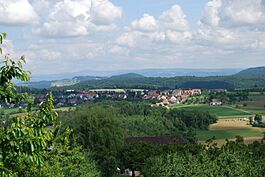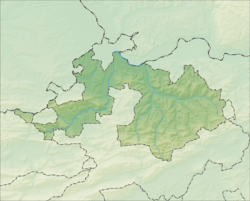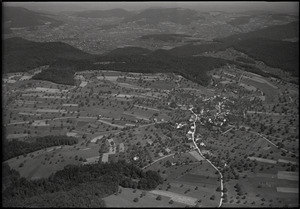Rünenberg facts for kids
Quick facts for kids
Rünenberg
|
||
|---|---|---|
 |
||
|
||
| Country | Switzerland | |
| Canton | Basel-Landschaft | |
| District | Sissach | |
| Area | ||
| • Total | 4.97 km2 (1.92 sq mi) | |
| Elevation | 595 m (1,952 ft) | |
| Population
(Jun 2021 )
|
||
| • Total | 748 | |
| • Density | 150.50/km2 (389.8/sq mi) | |
| Postal code |
4497
|
|
| Surrounded by | Gelterkinden, Häfelfingen, Kilchberg, Rümlingen, Tecknau, Zeglingen | |
Rünenberg is a small town, also called a municipality, located in the Sissach district. It is part of the canton of Basel-Country in Switzerland.
Contents
History of Rünenberg
Rünenberg was first written about in the year 1101. Back then, it was known as Runachperh.
This town is famous for being the birthplace of two important people:
- Johann August Sutter: He was a pioneer who played a big part in the history of California.
- Niklaus Riggenbach: He invented a special system for rack railways. These are trains that use a toothed rail to climb steep hills.
Geography of Rünenberg
Rünenberg covers an area of about 4.98 square kilometers (1.92 square miles). A large part of this land, about 55.2%, is used for farming. Forests cover another 37.8% of the area.
The remaining land is used for buildings and roads (6.8%). A very small part, about 0.2%, is made up of rivers or lakes. Most of the water in Rünenberg is flowing water, like streams.
Rünenberg is located on a high, flat area between two valleys: the Homburger valley and the Eital valley. The town itself is a linear village, meaning its buildings are spread out along a main road.
Rünenberg's Coat of Arms
Every town has a special symbol called a coat of arms. Rünenberg's coat of arms is blue. On it, you can see a white daisy flower with a yellow center.
People of Rünenberg (Demographics)
Rünenberg has a population of about 792 people. Most people in Rünenberg speak German (about 97.9%). A few people also speak French or Italian language.
In 2008, about 5% of the people living in Rünenberg were from other countries. Over the past 10 years, the number of people living here has grown by about 7.5%.
The population is almost evenly split between males (50.3%) and females (49.7%). Most people living in Rünenberg are Swiss citizens (95.2%).
Many people (about 35.9%) were born in Rünenberg and still live there. Others were born in the same canton (30.2%) or elsewhere in Switzerland (24.4%). About 8.5% of the people were born outside Switzerland.
In Rünenberg, the age groups are spread out. About 6.4% are young children (0-6 years old), and 15% are teenagers (7-19 years old). Adults make up the rest, with a good number of people in their 40s, 50s, and 60s. About 13.4% of the population is between 65 and 79 years old, and 4% are over 80.
Most households in Rünenberg have about 2.6 people. There are some households with just one person, and a few with five or more people.
The chart below shows how the population of Rünenberg has changed over many years:

Economy and Jobs in Rünenberg
In 2007, the unemployment rate in Rünenberg was very low, at 1.11%. This means almost everyone who wanted a job had one.
Many people work in different types of jobs:
- Primary sector: This includes jobs like farming and forestry. About 33 people work in this area.
- Secondary sector: This involves manufacturing (making things) and construction (building things). About 59 people work here.
- Tertiary sector: This covers service jobs, like sales, transportation, hotels, and education. About 44 people work in this sector.
In total, about 388 people from Rünenberg have jobs. About 40.5% of these workers are women.
Many people who live in Rünenberg travel to other towns for work. About 20.1% use public transportation, and 55.4% use their own car to get to work.
Religion in Rünenberg
Based on information from 2000, most people in Rünenberg belong to one of two main Christian groups:
- About 14.6% are Roman Catholic.
- About 67.9% belong to the Swiss Reformed Church.
Some people belong to other Christian churches, or are Islamic or Buddhist. About 15% of the population does not belong to any church.
Weather in Rünenberg
Rünenberg gets rain or snow for about 127.6 days each year. On average, it receives about 972 millimeters (38.3 inches) of precipitation annually.
The wettest month is May, with about 111 millimeters (4.4 inches) of rain or snow over 12 days. The driest month is February, with about 49 millimeters (1.9 inches) over 8.7 days.
The climate here is known as a "Marine West Coast Climate." This means it has mild differences between high and low temperatures, and it rains enough throughout the year.
| Climate data for Rünenberg (1991–2020) | |||||||||||||
|---|---|---|---|---|---|---|---|---|---|---|---|---|---|
| Month | Jan | Feb | Mar | Apr | May | Jun | Jul | Aug | Sep | Oct | Nov | Dec | Year |
| Mean daily maximum °C (°F) | 3.5 (38.3) |
4.9 (40.8) |
9.4 (48.9) |
13.6 (56.5) |
17.5 (63.5) |
21.1 (70.0) |
23.3 (73.9) |
22.9 (73.2) |
18.3 (64.9) |
13.4 (56.1) |
7.6 (45.7) |
4.4 (39.9) |
13.3 (55.9) |
| Daily mean °C (°F) | 1.0 (33.8) |
1.8 (35.2) |
5.5 (41.9) |
9.2 (48.6) |
13.0 (55.4) |
16.6 (61.9) |
18.6 (65.5) |
18.3 (64.9) |
14.2 (57.6) |
10.0 (50.0) |
4.9 (40.8) |
1.8 (35.2) |
9.6 (49.3) |
| Mean daily minimum °C (°F) | −1.5 (29.3) |
−1.1 (30.0) |
2.0 (35.6) |
5.1 (41.2) |
8.8 (47.8) |
12.4 (54.3) |
14.2 (57.6) |
14.2 (57.6) |
10.6 (51.1) |
7.0 (44.6) |
2.4 (36.3) |
−0.6 (30.9) |
6.1 (43.0) |
| Average precipitation mm (inches) | 54 (2.1) |
49 (1.9) |
58 (2.3) |
74 (2.9) |
111 (4.4) |
101 (4.0) |
108 (4.3) |
108 (4.3) |
82 (3.2) |
79 (3.1) |
73 (2.9) |
72 (2.8) |
972 (38.3) |
| Average precipitation days (≥ 1.0 mm) | 9.8 | 8.7 | 9.9 | 10.6 | 12.0 | 11.6 | 11.9 | 11.5 | 9.1 | 10.7 | 10.4 | 11.4 | 127.6 |
| Average relative humidity (%) | 81 | 76 | 70 | 67 | 71 | 71 | 69 | 71 | 76 | 81 | 83 | 82 | 75 |
| Mean monthly sunshine hours | 64 | 86 | 137 | 169 | 187 | 210 | 231 | 214 | 159 | 104 | 65 | 55 | 1,682 |
| Percent possible sunshine | 26 | 33 | 41 | 45 | 43 | 47 | 52 | 53 | 47 | 35 | 26 | 24 | 41 |
| Source: MeteoSwiss | |||||||||||||
Education in Rünenberg
About 49.2% of the people in Rünenberg have finished upper secondary education. This is like high school. Also, about 10.4% have gone on to higher education, like a university.
In 2000, 48 students from Rünenberg went to schools in other towns.
See also
 In Spanish: Rünenberg para niños
In Spanish: Rünenberg para niños





